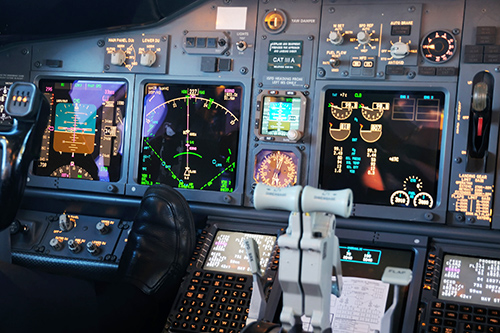Composing the Go-To Human Factors Guide for Flight Deck Enhancements
Modern cockpits, also known as flight decks, have hundreds of switches, alerts, and displays, and pilots are trained to know what each one of them does or indicates.
New technology can improve how flight decks present information to pilots, and how pilots interpret that information.
Before the Federal Aviation Administration (FAA) approves new or modified flight deck avionics, FAA personnel thoroughly evaluate whether those systems meet requirements and guidelines, and whether they support flight crew functions, tasks, and decisions—because bad design can potentially lead to pilot error.
The Challenge
Investigating how people interact with systems, such as flight deck controls and displays, is part of a field of study called human factors.

Flight decks are specifically designed to help pilots manage workload and errors, implement automation, and avoid and handle system failures.
Human factors requirements and guidelines for flight deck controls and displays are described across a variety of documents, from the Code of Federal Regulations to technical standard orders to advisory circulars to industry standards.
Many of those documents are several hundred pages long, but the human factors portions make up only a few pages, or the human factors guidance may be spread throughout a document. For FAA personnel certifying new avionics or proposed flight deck upgrades, reviewing numerous sources can be time-consuming and can lead to significant workload.
FAA is also responsible for developing the regulatory and guidance material for issues identified across systems, but there was previously no reference that had a comprehensive list of regulatory and guidance material.
The Solution
FAA called on Volpe to develop a single-source reference document for all human factors regulatory and guidance materials related to flight deck displays and controls, as well as recommendations and best practices. This document makes it easier to identify and resolve human factors issues with these systems during FAA’s evaluation process, and to develop new regulatory and guidance material.
The document focuses on 10 key human factors and pilot interface topics that FAA personnel identified across numerous aircraft certification projects, including important but sometimes overlooked issues, and issues for which industry personnel routinely request FAA regulatory and guidance material. The 10 topics include display hardware, design philosophy, error management, and automation.
The document also has six appendices that include the following:
- Sample requirement checklists
- Testing scenarios and procedures
- Key reference lists
- Gold star human factors research reports that have been useful for FAA and industry representatives who evaluate and approve flight deck displays and controls
This document does not replace FAA regulatory or guidance material and it does not provide a means of compliance. Current FAA regulations and guidance always take precedence.
The Impact
This document has had major impacts on the aviation industry. First, it is a go-to resource for FAA flight test pilots, engineers, and human factors specialists who evaluate flight deck systems and aim to resolve common human factors issues in proposed avionics. The document has also been helpful for FAA personnel who develop requirements, guidance, and issues papers.
In addition, FAA and Volpe had end-users in mind when creating this document, so it may also be useful to industry players. Avionics manufacturers can review human factors requirements related to flight deck displays and controls early on and throughout product development. The consideration of human factors aspects when designing avionics and conducting pilot-interface evaluations can help reduce costly design changes.
Across the aviation industry, this document raises the level of human factors awareness for designing and evaluating flight deck displays and controls. This document helps improve pilot performance and aviation safety by offering guidance that can resolve human factors issues and ensure design consistency and compatibility across flight decks.
